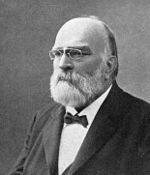astro.wikisort.org - Researcher
Nils Christoffer Dunér (Billeberga, Malmöhus län 21 May 1839 – Stockholm 10 November 1914) was a Swedish astronomer. His parents were Nils Dunér and Petronella (née Schlyter).[1]
Nils Christoffer Dunér | |
|---|---|
 Nils Christoffer Dunér (1909) | |
| Born | 21 May 1839 Billeberga, Malmöhus län |
| Died | 10 November 1914 (aged 75) Stockholm |
| Nationality | Swedish |
| Alma mater | Lund University |
| Awards | Rumford Medal in 1892 |
| Scientific career | |
| Fields | astronomy |
| Institutions | Uppsala University |
Dunér received his doctorate from Lund University in 1862, was observer at the observatory there from 1864 and Professor of Astronomy at Uppsala University from 1888.
He was awarded the Prix Lalande in 1887[2] and the Rumford Medal in 1892. The crater Dunér on the Moon is named after him. At Svalbard, Dunérfjellet on Svenskøya, Dunérbukta in Sabine Land, and Kapp Dunér, the western point of Bjørnøya, are named after him.[3][4][5]
References
- Hockey, Thomas (2009). The Biographical Encyclopedia of Astronomers. Springer Publishing. ISBN 978-0-387-31022-0. Retrieved August 22, 2012.
- Lockyer, Sir Norman (5 January 1888). "Paris. Academy of Sciences, December 26, 1887". Nature. 37 (949): 239–240. Bibcode:1888Natur..37..239.. doi:10.1038/037239a0.
- "Dunérfjellet (Svalbard)". Norwegian Polar Institute. Retrieved 4 June 2014.
- "Dunérbukta (Svalbard)". Norwegian Polar Institute. Retrieved 4 June 2014.
- "Kapp Dunér (Svalbard)". Norwegian Polar Institute. Retrieved 4 June 2014.
External links
На других языках
[de] Nils Christofer Dunér
Nils Christofer Dunér auch Nils Kristofer Dunér (* 21. Mai 1839 in Billeberga, Gemeinde Svalöv; † 10. November 1914 in Stockholm) war ein schwedischer Astronom.- [en] Nils Christoffer Dunér
[fr] Nils Christoffer Dunér
Nils Christoffer Dunér (Billeberga, Malmöhus län 21 mai 1839 – Stockholm 10 novembre 1914) était un astronome suédois. Ses parents étaient Nils Dunér et Petronella (née Schlyter)[1].[it] Nils Christoffer Dunér
Nils Christoffer Dunér (Billeberga, 21 maggio 1839 – Stoccolma, 10 novembre 1914) è stato un astronomo svedese.Текст в блоке "Читать" взят с сайта "Википедия" и доступен по лицензии Creative Commons Attribution-ShareAlike; в отдельных случаях могут действовать дополнительные условия.
Другой контент может иметь иную лицензию. Перед использованием материалов сайта WikiSort.org внимательно изучите правила лицензирования конкретных элементов наполнения сайта.
Другой контент может иметь иную лицензию. Перед использованием материалов сайта WikiSort.org внимательно изучите правила лицензирования конкретных элементов наполнения сайта.
2019-2025
WikiSort.org - проект по пересортировке и дополнению контента Википедии
WikiSort.org - проект по пересортировке и дополнению контента Википедии